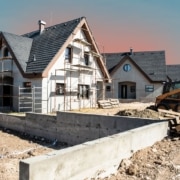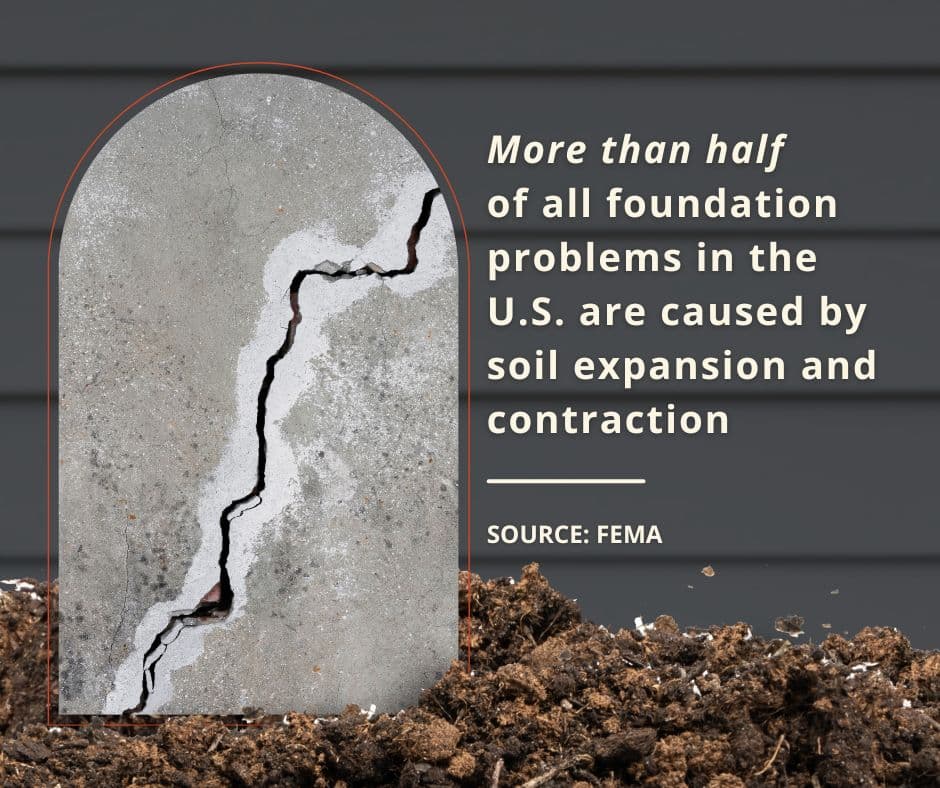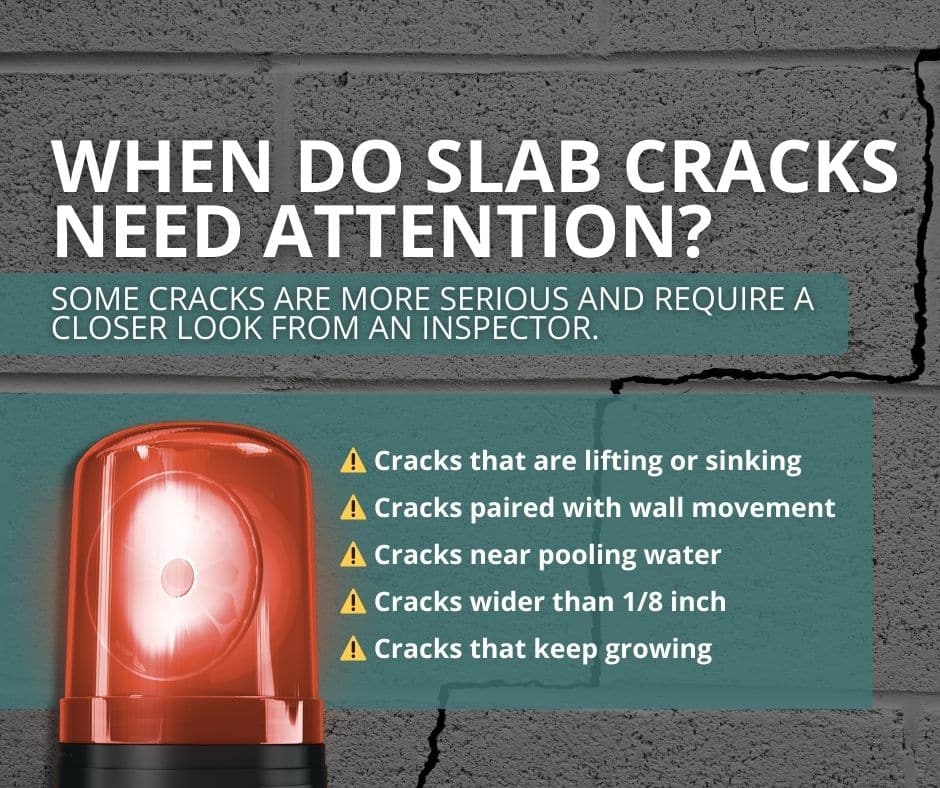What Might Cause a Crack in a Concrete Slab Foundation?
Homes with a concrete slab foundation are common in Florida, so it’s normal for homeowners to wonder what might cause a crack in one. Small cracks can come from routine settling, while wider or spreading cracks may point to soil movement, moisture changes, rushed construction, or other issues.
A home inspector can help distinguish the harmless cracks from the ones that need attention. Inside & Out Property Inspectors evaluates slab conditions during full home inspections, pre-listing inspections, and new construction phase inspections, including pre-slab and pre-drywall reviews.
This guide covers the most common causes of slab cracks in Northeast Florida and what different crack patterns may tell you about your home.
Why Slab Cracks Form in Florida Homes
Concrete is a strong material, but it reacts to temperature, soil conditions, and moisture levels. Jacksonville has a unique climate that places extra stress on homes with a concrete slab foundation, causing them to crack.
NOAA data shows that Jacksonville averages more than 50 inches of rainfall per year, with heavy rain concentrated in short seasonal bursts.
Soil in the region drains quickly in some areas and poorly in others, creating uneven pressure around the slab. FEMA notes that soil expansion and contraction are among the leading causes of slab movement nationwide.
Below are the primary reasons cracks form here.
1. Normal Settling
All homes settle. After construction, the soil adjusts under the structure’s weight, which can create minor surface cracks.
Normal settling often causes:
- Thin, hairline cracks
- Small surface lines across walkways, garage floors, or corners
- Shrinkage cracks that appear within the first few years
These cracks are usually only cosmetic. Inspectors record them, but typically see them in nearly every slab home in Jacksonville.
2. Soil Movement from Moisture Changes
Jacksonville soil expands when saturated and contracts when dry. This shifting puts pressure on the slab.
Moisture changes come from:
- Long periods of rain
- Standing water after storms
- Poor yard drainage
- Downspouts that empty near the home
- Seasonal droughts
The USGS notes that soils with varying sand and clay content are more prone to movement, which is common in many Florida neighborhoods.
Uneven soil movement can create cracks of different sizes and directions.
3. Improper Soil Compaction During Construction
Before a slab is poured, the soil must be compacted properly. If the fill material was not compacted enough during the building process, the home may settle unevenly.
This kind of settling can cause:
- Wider cracks
- Sloping or uneven floors
- Cracks that travel across large areas
Inside & Out frequently evaluates these conditions as part of pre-slab inspections, which help verify soil preparation before concrete is placed. Catching issues early prevents more serious settling later.
4. Moisture Accumulating Under the Slab
Moist soil under the slab softens the ground and causes part of the foundation to sink.
Moisture under a slab may come from:
- Plumbing leaks
- High groundwater during wet seasons
- Poor drainage around the home
- Low yard spots that hold water
Florida’s frequent summer storms increase the chance of soil saturation, especially in older neighborhoods with limited drainage systems.
5. Natural Concrete Shrinkage
Concrete shrinks slightly as it cures. This can create small cosmetic cracks.
Shrinkage cracks are:
- Thin
- Shallow
- Usually straight
- Common near edges
They often appear soon after the home is built and remain unchanged over time.
6. Tree Roots and Nearby Vegetation
Large roots can lift or shift sections of a slab.
Signs of root-related movement include:
- A slab corner that rises or sinks
- Cracks that widen slowly
- Uneven gaps between the slab and soil
Inspectors check root patterns, landscaping tree species, and proximity to the foundation to determine whether vegetation may be affecting slab performance.
7. Structural or Load Changes From Renovations
Changes made after construction can add stress to areas of the slab not designed to support it.
Examples include:
- Added rooms
- Heavy tubs or appliances
- Garage conversions
- Interior walls built over unsupported areas
Inspectors review the layout, visible supports, and signs of past renovations to determine whether added weight contributed to cracking.
What Different Crack Patterns May Mean
A crack’s size, shape, and location tell a lot about what caused it. While only a trained inspector can provide a reliable interpretation, these general patterns help homeowners understand what to look for.
| Crack Type | What It Tells You |
|---|---|
| Hairline cracks | Normal settling or shrinkage. Usually cosmetic. |
| Cracks along control joints | Expected movement where concrete is designed to expand. |
| Cracks wider than one-eighth inch | Possible soil movement or uneven settling. Needs attention. |
| Cracks with height difference | One side of the slab has shifted. Higher concern. |
| Long cracks across large areas | Slab or soil movement under the home. Often moisture-related. |
| Cracks paired with interior issues | Movement affecting the structure. Have an inspector review. |
How Inspectors Evaluate Slab Cracks
Inside & Out Property Inspectors uses a structured approach to understand the cause and severity of cracking.
1. Measuring and Documenting the Crack
Inspectors might note:
- Width
- Length
- Pattern
- Location
- Whether the crack is stable or active
This documentation creates a baseline for future comparison.
2. Checking for Related Clues
They examine:
- Door alignment
- Window movement
- Floor slope
- Wall cracks
- Trim gaps
These clues help determine whether the crack is isolated or part of a larger pattern.
3. Assessing Drainage and Exterior Conditions
Inspectors examine:
- Downspout placement
- Gutter performance
- Yard slope
- Standing water
- Soil erosion
Surface drainage is one of the biggest factors influencing slab movement in Florida.
4. Looking for Moisture Signs
Moisture meters and visual cues help identify:
- Plumbing leaks
- High soil moisture
- Moisture stains around the base of the walls
- Water pooling after storms
5. Considering Home Age and Construction Quality
Older homes often show expected settling. Newer homes with significant cracks may indicate early construction issues. This is why pre-drywall and pre-slab inspections are so important during new construction. They help identify issues before the slab is enclosed or the structure is fully built.
Should You Be Concerned About a Slab Crack?
Not every crack is a problem. However, some cracks deserve immediate attention.
Generally, low-concern cracks include:
- Hairline cracks
- Stable cracks that do not widen
- Cracks without vertical movement
- Shrinkage cracks near corners or edges
Cracks that may need further evaluation include:
- Cracks wider than one-eighth inch
- Cracks that grow over time
- Cracks with uplift or sinking on either side
- Cracks matched by wall or ceiling movement
- Cracks near significant water pooling
A home inspector can evaluate whether the crack is structural, moisture-related, or simply cosmetic.
How Florida Weather Influences Slab Cracks
Several regional factors shape how foundations move:
Heavy Rainfall
Short bursts of heavy rain raise moisture levels fast. Flood-prone areas, especially along low-lying neighborhoods, see more soil expansion.
Dry Season Shrinkage
After long dry spells, the soil pulls away from the foundation. The shift from wet to dry seasons makes movement more noticeable.
High Humidity
Humidity slows soil drying, which increases the chance of extended moisture exposure under the slab.
Coastal Influence
Homes near marshes, rivers, and the Intracoastal Waterway often sit on soil that drains unpredictably. These conditions help inspectors understand whether a crack fits normal seasonal patterns or indicates an ongoing problem.
Other Structure-Related Questions
These topics support internal linking across the site’s structural, roofing, and pre-purchase inspection content.
Why do some interior doors stick during certain months?
Seasonal humidity can swell framing or signal slight structural movement.
Can small wall cracks be normal?
Yes. Many appear near windows or corners. Inspectors check for patterns that match foundation behavior.
Can poor drainage affect the foundation?
Standing water near the home can cause uneven settling and soil softening.
Is a pre-slab inspection worth it for new construction?
Yes. Verifying soil preparation early can help prevent cracking and settling later.
Does roof runoff influence foundation health?
Improperly directed roof runoff can cause erosion or pooling that affects slab stability.
When to Call a Professional Inspector
Call a home inspector when:
- You notice new or widening slab cracks
- Floors feel uneven or slope in certain rooms
- Doors or windows begin sticking
- Water collects near the foundation after rain
- Wall or ceiling cracks appear near slab cracks
- You are buying or selling a home
- You are building a new home and want pre-slab or pre-drywall inspections to prevent early issues
Inside & Out Property Inspectors evaluates slab cracks as part of full home inspections and new construction phase inspections. If a crack shows signs of structural stress, the inspector may recommend further review by a foundation specialist or engineer.
Conclusion
A concrete slab foundation is tough, but it can crack for Jacksonville homes because the region’s soil and weather conditions naturally cause movement. Many cracks are only cosmetic, but some can point to moisture issues, soil changes, or early construction problems. Understanding the type of crack and what caused it helps homeowners make informed decisions.
Inside & Out Property Inspectors provides detailed evaluations that help you understand your foundation’s condition, identify early signs of movement, and protect the stability of your home.
Whether you need a full home inspection, a pre-listing evaluation, or a new construction phase inspection, our team provides clear guidance on what the cracks mean and what steps make sense next. Get a free quote and book your inspection today.





